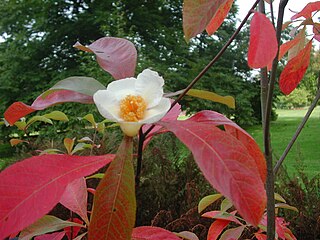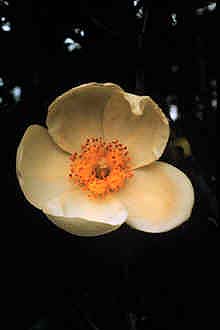
Theaceae, the tea family, is a family of flowering plants comprising shrubs and trees, including the economically important tea plant, and the ornamental camellias. It can be described as having from seven to 40 genera, depending on the source and the method of circumscription used. The family Ternstroemiaceae has been included within Theaceae; however, the APG III system of 2009 places it instead in Pentaphylacaceae. Most but not all species are native to China and East Asia.

Franklinia is a monotypic genus in the tea family, Theaceae. The sole species in this genus is a flowering tree, Franklinia alatamaha, commonly called the Franklin tree, and native to the Altamaha River valley in Georgia in the southeastern United States. It has been extinct in the wild since the early 19th century, but survives as a cultivated ornamental tree.

Gordonia is a genus of flowering plants in the family Theaceae, related to Franklinia, Camellia and Stewartia. Of the roughly 40 species, all but two are native to southeast Asia in southern China, Taiwan and Indochina. The remaining species, G. lasianthus (Loblolly-bay), is native to southeast North America, from Virginia south to Florida and west to Louisiana; G. fruticosa is native to the tropical rainforests of Central and South America, from Costa Rica to Brazil.

Gordonia lasianthus is a small to medium-sized evergreen tree or shrub found in acidic, swampy soils of pinelands and bays on the Atlantic and Gulf Coastal Plains of the southeastern United States. It is a member of the tea or family Theaceae. It is slow growing with soft, light-colored, fine-grained wood of little commercial value, although loblolly-bay could be managed as a source of pulpwood. When older specimens are cut, the wood exudes a strong scent. It is similar to a mixture of fresh oranges and pine sap. The bark of the adult tree varies from medium grey to a red brown coloration. Dead adult specimens of loblolly bay exhibit a lustrous shine when exposed to sunlight for several years. The white showy flowers and shiny foliage make it a desirable ornamental, but it is not easy to cultivate. Deer browse stump sprouts heavily.

The Nocardiaceae are a family of aerobic, non-fastidious, high G+C, Gram-positive actinomycetes that are commonly found in soil and water. Members of this family have been isolated from Antarctic soils. Nocardiaceae present coccobacilli, filamentous or, rarely, fragmented and palisading forms, and filamentous species grow in a branching morphological pattern similar to fungal hyphae.

Gordonia is an extinct genus of dicynodont therapsid from the Late Permian of Scotland. Fossils have been found from the Elgin sandstone of Cutties Hillock Sandstone in Elgin, Moray. These are among the many amniote fossils referred to as the Elgin Reptiles. Gordonia was named in 1893 with four species: G. traquairi, G. duffiana, G. huxleyana, and G. juddiana. Currently, the only recognized species is the type G. traquairi. All other species are considered synonyms of the type.

Nyssa biflora, commonly referred to as the swamp tupelo, or swamp black-gum is a species of tupelo that lives in wetland habitats. Swamp tupelo grows chiefly in the coastal plains from Delaware, eastern Maryland, and southeastern Virginia, south to southern Florida and west to eastern Texas. Its range extends north up the Mississippi Valley to southern Arkansas and west and south Tennessee.

α-Spinasterol is a stigmastane-type phytosterol found in a variety of plant sources such as spinach, from which it gets its name.
Gordonia is a genus of gram-positive, aerobic, catalase-positive bacterium in the Actinomycetota, closely related to the Rhodococcus, Mycobacterium, Skermania, and Nocardia genera. Gordonia bacteria are aerobic, motile, and non-sporulating. Gordonia is from the same lineage that includes Mycobacterium tuberculosis. The genus was discovered by Tsukamura in 1971 and named after American bacteriologist Ruth Gordon.. Many species are often found in the soil, while other species have been isolated from aquatic environments. Gordonia species are rarely known to cause infections in humans.
Ruth Evelyn Gordon (1910–2003) was an American bacterial taxonomist. She was member of the American Type Culture Collection. The bacterial genus Gordonia and species Mycobacterium gordonae are named after her.
Gordonia alkanivorans is a bacterium from the genus of Gordonia which has been isolated from soil which was contaminated with tar and phenol in Rositz in Germany. Gordonia alkanivorans has the ability to metabolize hexadecane. The strain RIPI90A of Gordonia alkanivorans can desulfurize dibenzothiophene.
Gordonia desulfuricans is a benzothiophene-desulphurizing bacterium from the genus Gordonia which has been isolated from soil from West Calder in Scotland.
Gordonia hankookensis is a Gram-positive, aerobic and non-motile bacterium from the genus Gordonia.
Gordonia humi is a Gram-positive and non-spore-forming bacterium from the genus Gordonia which has been isolated from soil near the mushroom Agaricus brasiliensis in Taiwan.
Gordonia lacunae is a bacterium from the genus Gordonia which has been isolated from soil from the Plettenberg Bay in South Africa.
Gordonia namibiensis is a bacterium from the genus Gordonia which has been isolated from soil from Kalahari in Namibia. Gordonia namibiensis metabolises nitrile.
Gordonia rhizosphera is a bacterium from the genus Gordonia which has been isolated from rhizosphere soil from a mangrove plant in Japan.
Gordonia shandongensis is a bacterium from the genus Gordonia which has been isolated from farmland soil in China.
Gordonia soli is a bacterium from the genus of Gordonia which has been isolated from soil in Taiwan.
Gordonia sp. nov. Q8 is a bacterium in the phylum of Actinomycetota. It was discovered in 2017 as one of eighteen new species isolated from the Jiangsu Wei5 oilfield in East China with the potential for bioremediation. Strain Q8 is rod-shaped and gram-positive with dimensions 1.0–4.0 μm × 0.5–1.2 μm and an optimal growth temperature of 40 °C. Phylogenetically, it is most closely related to Gordonia paraffinivorans and Gordonia alkaliphila, both of which are known bioremediators. Q8 was assigned as a novel species based on a <70% ratio of DNA homology with other Gordonia bacteria.






